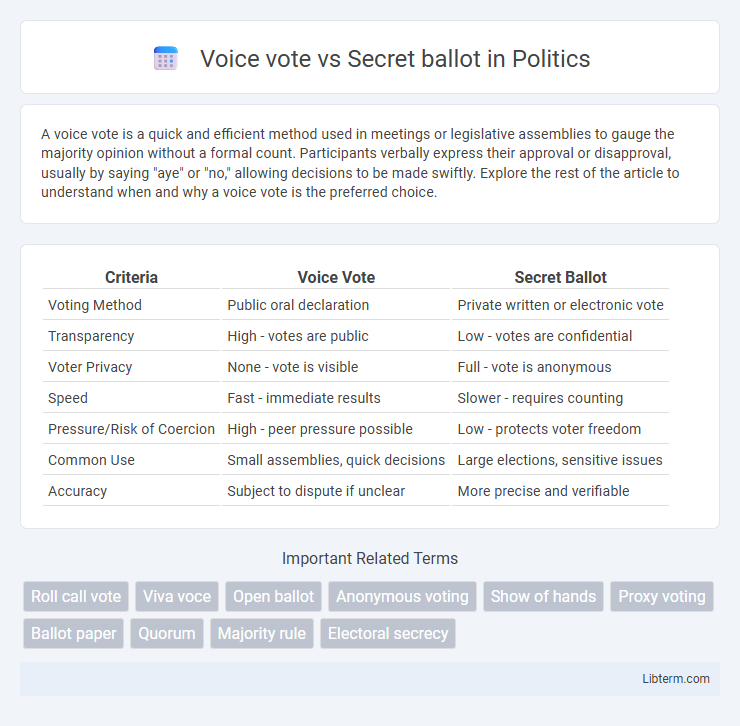A voice vote is a quick and efficient method used in meetings or legislative assemblies to gauge the majority opinion without a formal count. Participants verbally express their approval or disapproval, usually by saying "aye" or "no," allowing decisions to be made swiftly. Explore the rest of the article to understand when and why a voice vote is the preferred choice.
Table of Comparison
| Criteria | Voice Vote | Secret Ballot |
|---|---|---|
| Voting Method | Public oral declaration | Private written or electronic vote |
| Transparency | High - votes are public | Low - votes are confidential |
| Voter Privacy | None - vote is visible | Full - vote is anonymous |
| Speed | Fast - immediate results | Slower - requires counting |
| Pressure/Risk of Coercion | High - peer pressure possible | Low - protects voter freedom |
| Common Use | Small assemblies, quick decisions | Large elections, sensitive issues |
| Accuracy | Subject to dispute if unclear | More precise and verifiable |
Understanding Voting Methods: Voice Vote and Secret Ballot
Voice vote enables quick decision-making by having participants verbally express their support or opposition, making it ideal for low-stakes or non-controversial issues. Secret ballot ensures voter privacy and reduces undue influence by allowing individuals to cast votes anonymously, promoting fairness in elections or sensitive decisions. Comparing these methods highlights a trade-off between efficiency and confidentiality in democratic processes.
Definition and Process of Voice Vote
A voice vote is a parliamentary procedure in which members verbally express their support or opposition to a proposal by saying "aye" or "no," allowing the chair to quickly gauge majority approval without recording individual votes. This method is commonly used for routine decisions or when consensus is apparent, facilitating speedy outcomes through audible responses rather than written or electronic means. The chair assesses the volume of responses to determine the result, while voice votes lack anonymity compared to secret ballots where voters cast confidential votes to ensure privacy and reduce influence.
Definition and Process of Secret Ballot
A secret ballot is a voting method ensuring voter privacy by allowing individuals to cast their votes anonymously, preventing coercion or influence. The process involves distributing ballots to voters who mark their choice privately, then deposit the completed ballots into a sealed box for counting. This system contrasts with a voice vote, where voters call out their preferences publicly, potentially compromising anonymity and fairness.
Historical Context: Evolution of Voting Practices
The evolution of voting practices from voice votes to secret ballots marked a significant advancement in democratic processes, enhancing voter privacy and reducing coercion. Historically, voice voting was common in ancient Greek assemblies and early English parliaments, but it exposed voters to social pressure and potential retaliation. The introduction of the secret ballot, notably with the Australian Ballot in the 1850s, revolutionized elections by enabling anonymous voting and promoting fairer electoral outcomes.
Advantages of Voice Voting in Decision Making
Voice voting enables quick and efficient decision-making by allowing participants to express their opinions audibly, facilitating immediate consensus assessment. It promotes transparency and accountability, as votes are cast openly, reducing the likelihood of fraudulent practices. This method is especially advantageous in large assemblies where speedy resolution is essential and formal record-keeping is less critical.
Advantages of Secret Ballot for Transparency and Fairness
The secret ballot ensures voter anonymity, preventing coercion and vote-buying, which enhances election integrity. By safeguarding privacy, it promotes honest and independent choices, leading to more accurate representation of the electorate's will. This method minimizes undue influence and intimidation, fostering transparency and fairness in democratic processes.
Disadvantages and Limitations of Voice Vote
Voice vote often lacks voter anonymity, increasing the risk of peer pressure and social influence on participants. This method can result in inaccurate or biased outcomes due to the inability to verify individual votes or measure exact voter preferences. Additionally, voice votes are less effective in large assemblies where distinguishing vocal responses becomes challenging, leading to potential miscounts.
Disadvantages and Challenges of Secret Ballot
Secret ballots often face challenges such as increased administrative complexity and higher costs due to the need for secure materials and trusted personnel. They may also lead to slower vote counting processes, which can delay results and reduce immediate transparency. Furthermore, the secrecy can sometimes enable vote-buying or coercion since accountability is less visible.
Voice Vote vs Secret Ballot: Key Differences
Voice vote is a public voting method where participants verbally express their choice, enabling immediate transparency but potentially exposing voters to peer pressure. Secret ballot ensures voter anonymity by allowing individuals to cast votes privately, promoting confidentiality and reducing influence from external factors. The key differences lie in transparency, voter privacy, and susceptibility to coercion, with voice vote favoring openness and secret ballot prioritizing confidentiality.
Choosing the Right Voting Method: Factors to Consider
Choosing the right voting method depends on factors such as the need for transparency, confidentiality, and the sensitivity of the issue being decided. Voice votes enable quick, public decisions suitable for non-controversial matters where voter anonymity is less critical, while secret ballots protect voter privacy and reduce coercion in sensitive or contested elections. Consider the size of the voting body, the importance of accuracy, and the potential impact of social pressure when selecting between voice vote and secret ballot.
Voice vote Infographic

 libterm.com
libterm.com